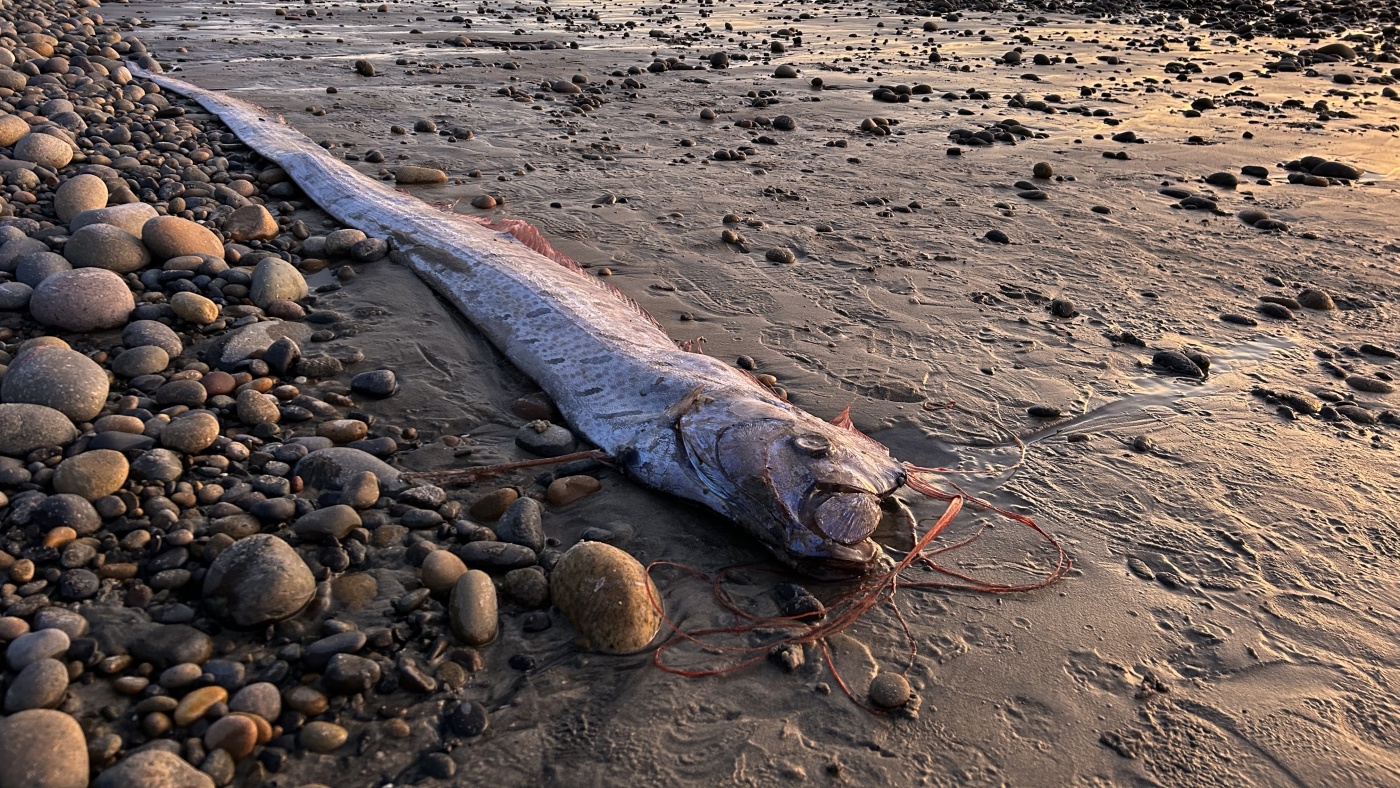
Scripps Oceanography Ph.D. candidate Alison Laferriere spotted an oarfish washed up on Grandview Beach in Encinitas, Calif., this month. It was the third found in Southern California since August.
Alison Laferriere/Scripps Institution of Oceanography
hide caption
toggle caption
Alison Laferriere/Scripps Institution of Oceanography
A deep-sea creature steeped in folklore has once again washed ashore in California.
On Nov. 6, a researcher on an Encinitas beach spotted an oarfish, measuring 9 to 10 feet long. The fish typically swim at depths of 300 to 3,000 feet and are rarely seen on the surface. Yet it was the third time one has appeared in Southern California since August.
They have been associated with bad omens, according to English-language accounts of Japanese folklore.
The fish, which can grow to 30 feet in length and feed on krill, have typically washed up on beaches when injured or disoriented, according to scientists.
The current group of oarfish washing ashore “may have to do with changes in ocean conditions and increased numbers of oarfish off our coast,” Ben Frable, manager of the Scripps Oceanography Marine Vertebrate Collection at UC San Diego, said in a statement. “Many researchers have suggested this as to why deep-water fish strand on beaches. Sometimes it may be linked to broader shifts such as the El Niño and La Niña cycle but this is not always the case,” he said, adding that many variables could be the cause.
The previous fish were discovered in Huntington Beach in September and in La Jolla in August, according to Scripps. Before August’s discovery, scientists had only recorded 19 oarfish that had washed up on the California coast since 1901, the oceanography researchers said.
Fish and muddled folklore
Oarfish have been found around the globe, but one particular country’s history with the fish has gathered the most attention: Japan.
According to some media reports, oarfish have been associated in Japanese folklore with prophesies of doom — in particular, earthquakes.
Researchers in Japan looked into this in 2019: “In Japan, folklore says that uncommon appearances of deep‐sea fish are an earthquake precursor. If this folklore is proved to be true, the appearance of deep‐sea fish could be useful information for disaster mitigation,” a group from Tokai University and the University of Shizuoka wrote. But they scoured news reports of deep-sea fish washing up and determined that there wasn’t much of a relationship between those sightings and earthquakes.
Some accounts say the oarfish were known in centuries past as ryugu no tsukai, roughly translating to a “messenger from the Dragon Palace.”
Yoshiko Okuyama, a professor of Japanese studies at the University of Hawaii at Hilo, pointed to a Japanese fairy tale with source text dating back to the 8th century. It tells the story of a fisherman named Urashima Taro who, in return for saving a turtle, is taken to the underwater palace of the Dragon King, Ryugu-jo.
“In Japan several different sea creatures have been called the Messenger of the Dragon Palace. The list includes eels and turtles,” she said in an email. Adding oarfish to that list was “plausible — anything mysterious from the sea can be imagined as such, right?” but she said she was unable to immediately verify it with source material.
A database of Japanese folklore describes ryugu no tsukai as “large fish with human heads, horns, long hair, and sometimes beards.” In a retelling of a legend on the folklore database, the creatures were a bit of a mixed bag. They foretold of death and disease, but said people would be saved so long as they “hear my message.”



